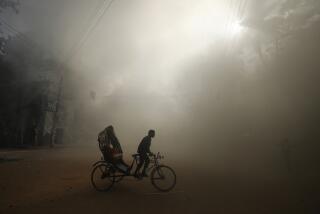Speaking Of: : The Ongoing Tragedy of Bangladesh
- Share via
“Bangladesh, Bangladesh,
Where so many people are dying fast
And it sure looks like a mess.”
That’s how George Harrison saw this land of seemingly perennial disaster when the former Beatle wrote a song about it for an Aug. 1, 1971, famine relief concert in New York’s Madison Square Garden.
Last week’s cyclone, which is believed to have killed more than 125,000, is, in fact, only the latest in a long line of natural and man-made disasters going back for as long as there are written records.
The poor, overcrowded country is particularly susceptible to killer windstorms--all of the most deadly cyclones (known in other parts of the world as hurricanes or typhoons) in the last 50 years have battered Bangladesh.
But it also suffers more than its share of other plagues including: * Tidal waves--Walls of water up to 30 feet high follow a cyclone. * Floods--Monsoon rains, which dump an average of 80% of the country’s heavy annual rainfall during the June-October months, regularly flood one-third of the country and in bad years leave 70% of it under water. * Famine--Crop damage during floods and cyclones often plunges many Bangladeshis into malnutrition soon afterwards. * Disease--Food shortages and unsanitary living conditions contribute to widespread cholera, leprosy, and tuberculosis. Malaria, spread by mosquitoes that thrive in the nation’s swampy regions, kills thousands every year. * Man-made tragedy--There are frequent reports of drownings when overloaded ferries, a main means of transportation, sink in the country’s waterways. An estimated 3 million people died in the 1970-71 war that resulted in the political separation of Bangladesh from Pakistan.
COMPARISONS
Population density per square mile, in persons California 189 people per square mile.
Bangladesh, 2063 per square mile.
Total area,in square miles
Bangladesh: 55,596 square miles
California: 158,706 square miles
Per capita income, in dollars:
Bangladesh: $113
California: $19,740
Water: A Constant Threat
Deforestation: Woodcutting, particularly in Nepal, has stripped away much Himalayan timber, speeding water runoff and erosion of the mountains.
Rivers: Known as the drainpipe of Central Asia, several river systems originating in the mountainous north flow through Bangladesh to the ocean, creating what is reputedly the largest deltaic region in the world.
Cyclones: Storm are spawned over the Indian Ocean, then drawn as if by a magnet up the shallow Bay of Bengal. These often cause tidal waves, walls of water up to 30 feet high, to blow in off the Bay of Bengal.
Why is Bangladesh vulnerable to these disasters? River systems originating in the mountainous north of the subcontinent flow through Bangladesh to the ocean, creating what is reputedly the largest deltaic region in the world. Most of the country’s 110 million people are crammed onto islands that speckle the delta. The islands are no more than 10 feet above sea level, so there is no high ground to seek refuge when disaster strikes.
Bangladesh is one of the world’s poorest and most overpopulated countries. If California had the same population density as Bangladesh, it would have nearly 12 times as many people as it does--more people than the U.S. and Japan combined. Some past disasters in Bangladesh or the territory it occupied before independence:
Year Date Casualties/Disaster 1942 Oct. 15-16 40,000/hurricane 1960 Oct. 10 6,000/flood Oct. 31 4,000/flood 1961 May 10,000/cyclone 1963 May 28-29 22,000 windstorm 1965 May 11-12 17,000 windstorm June 1-2 30,000/windstorm Dec. 15 10,000 windstorm 1970 Nov. 13 300,000/cyclone, tidal wave 1974 Aug. 12 40,000/flood, famine 1984 April-May 1,200/cholera 1985 May 25 10,000/cyclone 1987 Aug. 2 1,800/flood 1988 Sept. 6 2,100/flood 1989 April 26 1,007/cyclone
SOURCE: 1989 World Almanac, CIA World Factbook, Library of Congress
More to Read
Sign up for Essential California
The most important California stories and recommendations in your inbox every morning.
You may occasionally receive promotional content from the Los Angeles Times.










